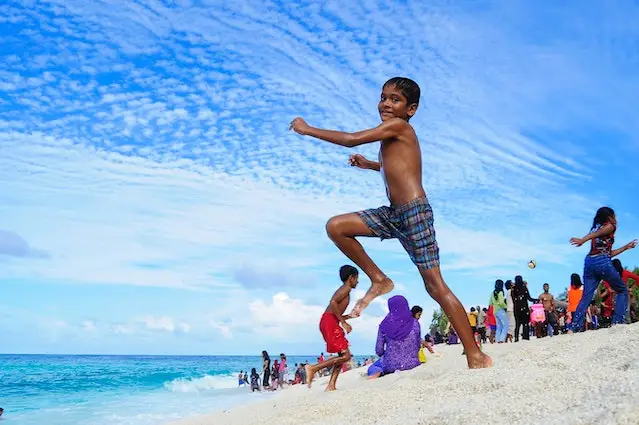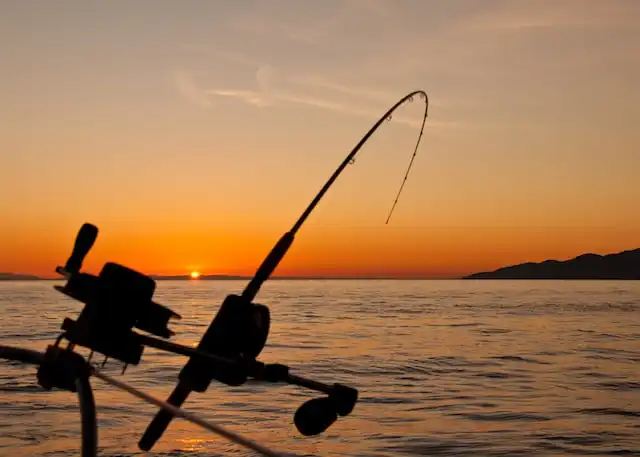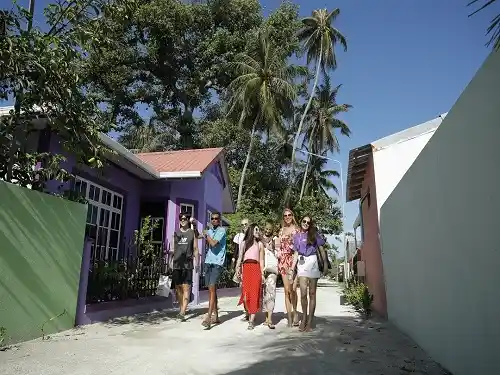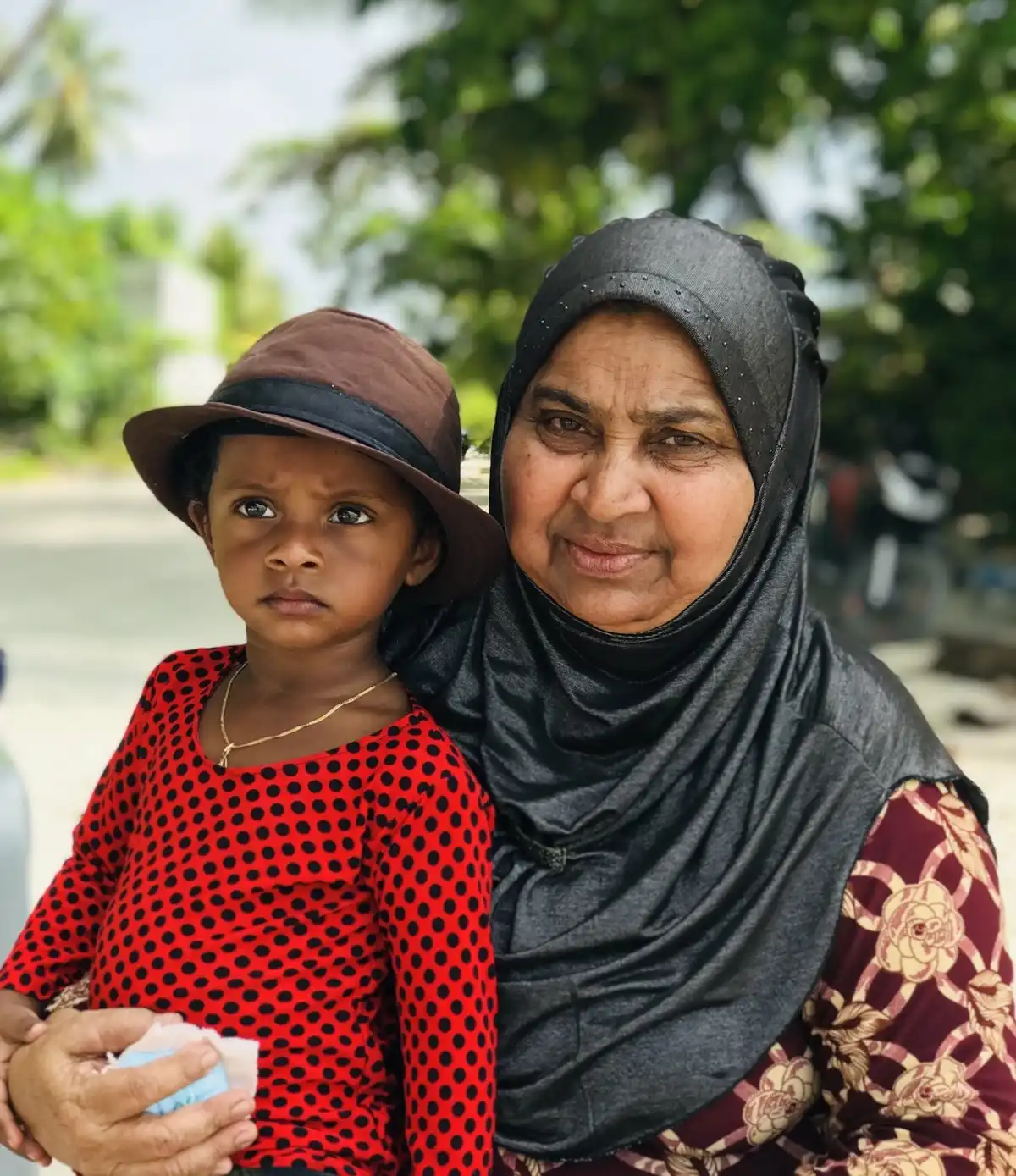Discover a maritime northern paradise with traditional boat building heritage, navigational expertise, pristine beaches, and authentic Maldivian lifestyle in the remote Haa Alifu Atoll
Located in the Haa Alifu Atoll in the northern Maldives, Vashafaru Island offers visitors a rare glimpse into authentic Maldivian island life in one of the country's most pristine and remote regions. This peaceful island maintains its natural beauty and cultural heritage while providing access to some of the Maldives' most untouched environments.
What makes Vashafaru special is its rich maritime heritage and traditional boat building expertise. The island has long been known for its skilled craftsmen who construct and maintain traditional Maldivian dhonis (wooden boats), continuing centuries-old techniques that have been passed down through generations. This boat building tradition has created a strong maritime identity that shapes many aspects of island life.
Visitors to Vashafaru are drawn by its maritime heritage, pristine beaches, exceptional snorkeling opportunities, and chances to engage with local community life. The island's remote location in the northern Maldives means fewer tourists and a more authentic experience, while its natural environment offers diverse activities both on land and in the surrounding crystal-clear waters.
Vashafaru Island is situated in the northern part of the Maldives in Haa Alifu Atoll, approximately 335 kilometers north of Male. This remote location in the northern atolls provides a more pristine and less-visited environment compared to islands closer to the capital.
Its position within Haa Alifu Atoll offers access to some of the Maldives' most spectacular diving and snorkeling sites, with healthy coral reefs and abundant marine life. The northern atolls are known for their exceptional biodiversity both above and below the water.
Vashafaru Island stands out among Maldivian islands for its preserved traditional boat building expertise and strong maritime heritage, offering visitors a glimpse into the seafaring traditions that have been central to Maldivian culture for centuries.

Vashafaru is renowned for its traditional dhoni (wooden boat) construction, where skilled craftsmen use techniques passed down through generations to build and maintain these iconic vessels that have been the backbone of Maldivian maritime culture.

The island is known for its navigational knowledge, with elders preserving traditional methods of wayfinding using stars, currents, and natural elements that allowed Maldivians to navigate the vast Indian Ocean long before modern technology.

Beyond its maritime heritage, Vashafaru boasts untouched white sand beaches with crystal-clear waters, offering the classic Maldivian beach experience without the crowds found on more developed islands.

Vashafaru is home to a close-knit community that has maintained traditional island values and maritime practices, offering visitors authentic cultural interactions rarely found in more touristic areas.
Vashafaru's maritime heritage includes several distinctive elements:
These maritime traditions make Vashafaru an ideal destination for travelers interested in experiencing a different aspect of Maldivian cultural heritage and understanding the seafaring traditions that have connected the scattered islands of the Maldives for centuries.
The traditional boat building process on Vashafaru includes several key stages:
These boat building techniques represent a living maritime heritage that connects present-day Vashafaru to centuries of Maldivian seafaring tradition, creating vessels perfectly adapted to local waters and conditions.
Vashafaru offers a limited but authentic range of accommodation options that focus on genuine experiences and local hospitality. The island's guesthouses provide comfortable stays while maintaining strong connections to the local community and traditional lifestyle.

A small number of family-operated guesthouses offer clean, comfortable accommodations with personal service. These properties feature air-conditioned rooms with private bathrooms, home-cooked Maldivian meals, and direct access to local knowledge through host families.
Price Range: $45-75 per night
Features: Authentic hospitality, cultural insights, local excursion arrangements

For travelers seeking the most authentic experience, some boat-building families offer homestay accommodations where guests can live alongside local families, observe traditional boat construction, and gain deeper insights into maritime island life.
Price Range: $40-65 per night
Features: Cultural immersion, boat building demonstrations, participation in daily island activities

A limited number of properties offer beachfront locations with direct access to the island's beautiful shores. These accommodations provide stunning ocean views and the soothing sounds of waves, creating a peaceful environment for those seeking proximity to the sea.
Price Range: $60-90 per night
Features: Beach access, ocean views, water sport facilities
Vashafaru is blessed with pristine beaches and a spectacular marine environment. The island's remote location in the northern atolls ensures the surrounding reefs remain in excellent condition, offering fantastic snorkeling and marine encounters.
Vashafaru features stunning white sand beaches that remain largely untouched by tourism development. The eastern beach is particularly impressive, with powdery sand and crystal-clear turquoise waters that create postcard-perfect vistas. The western side offers a more sheltered environment, with calm waters ideal for swimming.
The island has a designated "bikini beach" where tourists can wear Western-style swimwear. This beautiful stretch of sand provides a relaxing environment while respecting local cultural norms. The remaining beaches require modest dress as they are used by the local community.
Unique to Vashafaru is the traditional boat building area along parts of the coastline, where visitors can observe the construction and maintenance of dhonis. This area provides fascinating insights into the island's maritime traditions and boat building skills, with the sounds of traditional tools and the smell of wood creating an authentic atmosphere.


The waters around Vashafaru Island offer exceptional marine biodiversity:
Haa Alifu Atoll is known for its exceptional marine biodiversity and healthier coral systems compared to some southern atolls, making Vashafaru an ideal base for underwater exploration.
Vashafaru offers a unique blend of maritime experiences and natural adventures. The island's boat building traditions provide visitors with opportunities to connect with a different aspect of Maldivian culture while enjoying its pristine natural environment.











Vashafaru is home to a close-knit community of approximately 450 residents who maintain strong traditional values and maritime heritage. The island's population is known for its warm hospitality, boat building expertise, and preservation of authentic Maldivian culture.
Daily life on Vashafaru revolves around the rhythm of boat building, fishing activities, prayer times, and community gatherings. Mornings often begin with craftsmen working on dhoni construction or maintenance, while fishermen head out to sea in traditional vessels. The island awakens with the call to prayer, followed by a day of work, family responsibilities, and community interactions. Boat building and fishing form the economic backbone of the island, with many households involved in these traditional activities. This maritime lifestyle has created a sustainable approach to island living that continues to this day.
Vashafaru preserves many traditional Maldivian customs and cultural practices. Religious observances play an important role in community life, with festivals like Eid celebrated enthusiastically. Cultural expressions such as Boduberu performances remain vibrant, while traditional practices including boat building, navigation, and fishing techniques are still maintained by community members. The island's relative isolation in the northern atolls has helped preserve these traditions with less outside influence than islands closer to Male.
What makes Vashafaru's community special is their deep connection to the sea and boat building traditions. The knowledge of wood selection, boat construction techniques, navigation, and maritime skills has been passed down through generations, creating a distinctive maritime identity. Community members take pride in their boat building expertise and the island's reputation for quality vessels. This maritime focus shapes many aspects of island life, from daily routines to celebrations, creating a community identity that is deeply intertwined with the surrounding ocean.


Discover the boat building heritage, navigational expertise, pristine beaches, and genuine island lifestyle of Vashafaru. Book your stay today for an unforgettable maritime and natural experience in Haa Alifu Atoll.
Plan Your TripThe most convenient way to reach Vashafaru is by domestic flight from Male to Hanimaadhoo Airport (50-60 minutes), followed by a 40-minute speedboat transfer. Due to the island's remote location in the northern atolls, direct public ferry services from Male are limited. Most guesthouses can arrange the complete transfer from Male, including the domestic flight and speedboat connection. When planning your journey, remember that weather conditions can occasionally affect flight schedules in this region, so it's advisable to allow buffer days in your travel plans. The journey to Vashafaru is part of the adventure, offering beautiful aerial views of the Maldivian atolls during the flight and a chance to experience the stunning blue waters during the speedboat transfer.
Vashafaru's boat building traditions stand out in the Maldives because the island has preserved traditional dhoni construction techniques that have been practiced for centuries. The traditional Maldivian dhoni is a handcrafted wooden vessel with a distinctive shape that has been perfectly adapted to local waters through generations of refinement. What makes Vashafaru special is the concentration of skilled boat builders who continue to use traditional methods alongside modern adaptations. The island's craftsmen employ a "shell-first" construction technique where the hull is built before the internal framework, a method that differs from many other boat building traditions. They maintain knowledge of selecting appropriate woods for different parts of the vessel, understanding which varieties offer the best combination of strength, flexibility, and resistance to saltwater. Traditional tools are still used alongside modern equipment, preserving craftsmanship skills that require years to master. The community maintains ceremonial aspects of boat building, including rituals and celebrations associated with launching new vessels, reflecting the spiritual significance of boats in Maldivian culture. These preserved traditions offer visitors insights into the maritime heritage of the Maldives and the opportunity to observe authentic boat construction techniques that are becoming increasingly rare as modern fiberglass vessels replace traditional wooden dhonis in many parts of the country.
The best time to visit Vashafaru Island is during the northeast monsoon season (December to April), which brings dry, sunny weather with lower humidity and calmer seas. This period is ideal for water activities, with excellent visibility for snorkeling and diving. For those interested in experiencing the island's boat building traditions, this dry season is also excellent as many construction activities take place outdoors, benefiting from the favorable weather. The southwest monsoon (May to November) brings occasional rain showers but also lower prices and fewer tourists. This season can still be good for cultural experiences, though some outdoor boat building demonstrations may be affected by rain. Water temperature remains warm (27-30°C/80-86°F) throughout the year. Due to Vashafaru's northern location, it may experience slightly different weather patterns than southern atolls, with the possibility of brief rain showers even during the dry season. The shoulder months of November and April often offer a good balance of favorable weather and lower visitor numbers.
Accommodation on Vashafaru is limited and simple, reflecting the island's authentic character and minimal tourism development. The island offers a small number of family-run guesthouses that provide clean, comfortable rooms with basic amenities including air conditioning, private bathrooms with hot water, and Wi-Fi (though connectivity may be inconsistent). Most accommodations offer full-board packages that include three home-cooked Maldivian meals daily, featuring fresh seafood caught by local fishermen. Some boat-building families also offer homestay experiences where guests stay in a room within a family home, providing deeper cultural immersion and the opportunity to observe traditional boat construction up close. A few properties are located near the beach, offering easy access to the island's beautiful shores. Luxury amenities are limited, and the focus is on authentic experiences rather than high-end facilities. What these accommodations lack in luxury, they make up for in personal service, cultural insights, and genuine hospitality. Visitors should adjust their expectations accordingly and embrace the opportunity to experience authentic island life rather than expecting resort-style amenities.
Yes, visitors to Vashafaru have excellent opportunities to observe traditional boat building activities, which is one of the island's unique attractions. Most guesthouses can arrange for guests to visit boat building areas where you can watch skilled craftsmen at work constructing and maintaining traditional dhonis. These visits provide fascinating insights into the tools, techniques, and materials used in creating these iconic Maldivian vessels. Some boat builders are happy to explain their work, demonstrating specific techniques such as plank bending, joining methods, or traditional caulking. Depending on the stage of construction during your visit, you might observe different aspects of the boat building process, from initial hull shaping to finishing work. For those with a deeper interest, extended workshops can sometimes be arranged where you can learn about the entire boat building process from wood selection to launching. Photography is usually permitted with permission, allowing you to document this traditional craft. Some accommodations offer more immersive experiences where visitors can stay with boat building families, providing opportunities to observe the daily rhythm of this traditional work. These activities provide not just entertainment but educational insights into a maritime heritage that has shaped Maldivian culture for centuries. The level of engagement can be adjusted based on your interest, from brief observation to more in-depth learning experiences.